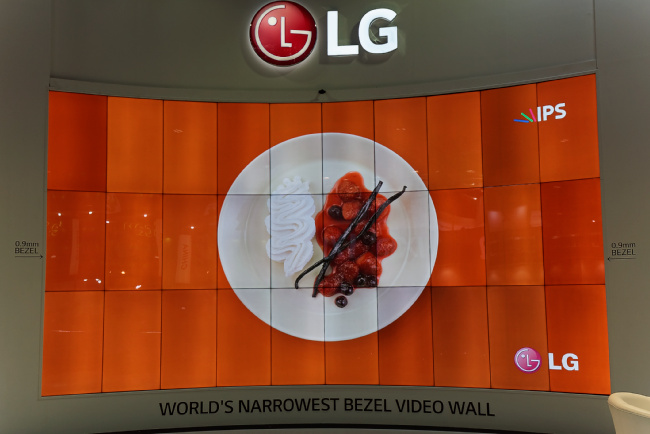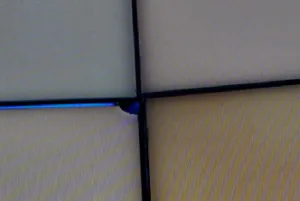Like Samsung, LG at Gitex was highlighting its B2B business and there was no significant consumer presence.
LG used Gitex as the “official” worldwide launch for its 0.9mm (1.8mm) ultra narrow bezel products. The technology was shown at Infocomm, but was a “future technology”. There was a large area of panels, but performance, while much better than the awful display at Infocomm, was still pretty poor in terms of uniformity. One of the panels also had an obviously broken corner (and gossip put the number of panels broken during installation at three!)
 LG UltraNarrow Bezel Displays still have poor uniformity – better than Infocomm, but a long way from good enough, in our view
LG UltraNarrow Bezel Displays still have poor uniformity – better than Infocomm, but a long way from good enough, in our view
One of the ultra narrow bezel panels was broken
 Also new on the booth was an 86″ “ultrastretch” display which has a 58:9 aspect ratio with 3840 x 600 resolution. LG’s monitor with this panel will have an integrated WebOS controller. Although stretch displays have not been particularly successful in volume terms, LG told us that it has had a very good response from QSR operators to the format as it allows very flexible operation – you are not limited to a fixed number of panels by the bezels. The weight is also just 25kg making mounting easier. The company would not quote a list price to us as it is still in discussion and should be finalised close to shipment in December or January. (this looks like a very good way to use up rejected 98″ UltraHD panel segments to us – Man. Ed.)
Also new on the booth was an 86″ “ultrastretch” display which has a 58:9 aspect ratio with 3840 x 600 resolution. LG’s monitor with this panel will have an integrated WebOS controller. Although stretch displays have not been particularly successful in volume terms, LG told us that it has had a very good response from QSR operators to the format as it allows very flexible operation – you are not limited to a fixed number of panels by the bezels. The weight is also just 25kg making mounting easier. The company would not quote a list price to us as it is still in discussion and should be finalised close to shipment in December or January. (this looks like a very good way to use up rejected 98″ UltraHD panel segments to us – Man. Ed.)
WebOS has now been upgraded to version 2.0 and the big change is the inclusion of touch support, which means that an overlay can simply be supported by adding it to one of LG’s smart signage displays. The latest version uses a quad core processor with 2GB of DRAM and 8GB of Flash memory. Wi-Fi support is built in and the new version supports mirroring from mobile devices without additional software.
LG has also decided to add “Beacons” to its mid-range and high end smart digital signage displays. Details of the protocols supported were not clear (as we understand it, there are more than one with Apple and Google both active in the area). As with touch, the availability of WebOS means that supporting the beacons is relatively simple. (for readers not familiar with the concept, the beacon is a simple transmitter of a unique id via bluetooth low energy (BLE). The id is used by an app in the user’s smartphone to trigger an action or message or direct the app to a web page)
The upper end of the digital signage range has also had integrated audio added back in as there is a feeling among some users that they want to use audio to help draw attention to digital signs in some situations.
The 84″ UltraHD display that LG is shipping now has a “wireless pen tray” for education use. The company has also adopted some Korean software called Sangon that is said to have captured 80% of the Korean education market.
On the topic of UltraHD, the company will introduce UltraHD panels in 49″, 55″, 65″ and 75″ in its B2B business.
LG told us at Infocomm that it would join in the rush to the LED display business. We got a bit more “flesh on the bone” at Gitex. The firm plans to support indoor and outdoor displays from 1.6mm to 20mm. The company told us that LG CNS was a main contractor in the last refurbishment of the “Fremont St Experience” in Las Vegas and LG Innotek has a lot of experience with LEDs. (as long ago as 2006, we reported CNS as winning stadium display deals including LEDs). The company plans to offer alternatives of Cree or Nichia LEDs and is looking for both projects and partners in the region.
LG also confirmed that it plans to start to offer 4mm flexible OLED displays for digital signage applications in Q1 2016. We asked about lifetime issues, but LG told us that it is confident that lifetimes will be competitive with LCD and other technologies.
Finally, the company showed us its 10″ Android-based system for room bookings etc. The system uses OneLan software and supports Android and WebOS.

